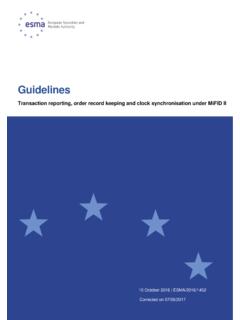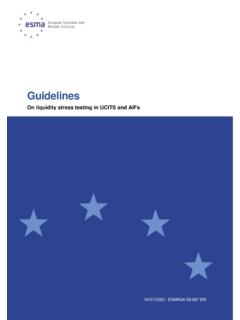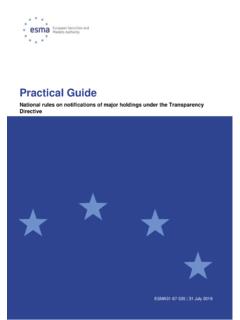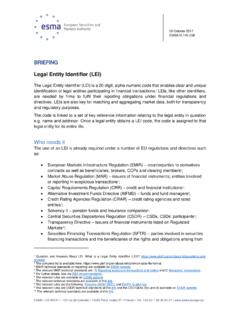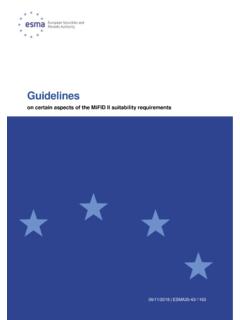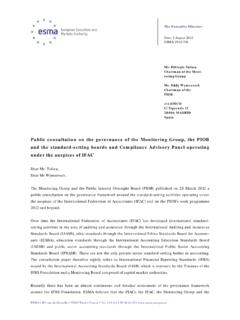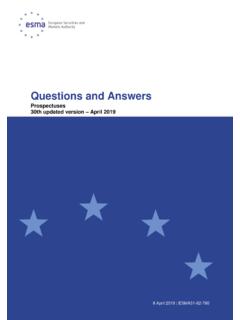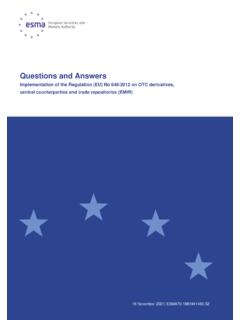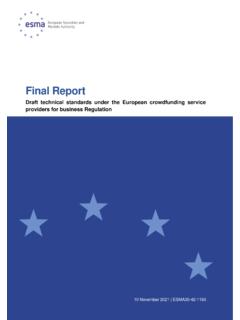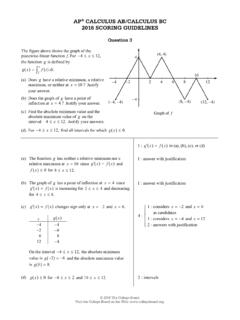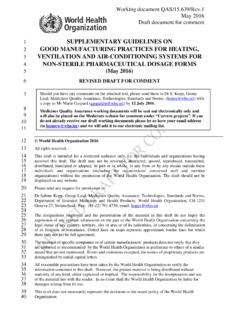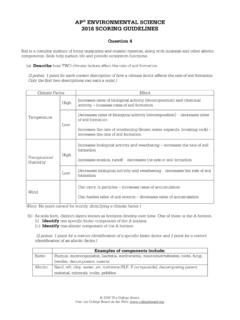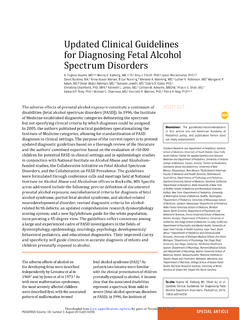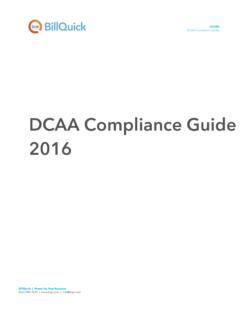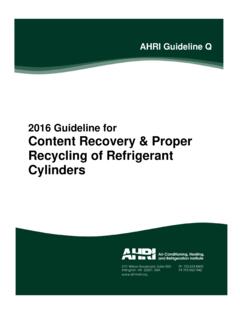Transcription of Questions and Answers - ESMA
1 16 December 2016 | ESMA/ 2016 /1669 Questions and Answers Application of the AIFMD ESMA CS 60747 103 rue de Grenelle 75345 Paris Cedex 07 France Tel. +33 (0) 1 58 36 43 21 2 Date: 16 December 2016 ESMA/ 2016 /1669 Contents Section I: Remuneration ..5 Section II: Notifications of AIFs ..8 Section III: Reporting to national competent authorities under Articles 3, 24 and 42 . 10 Section IV: Notification of AIFMs .. 27 Section V: MiFID services under Article 6(4) of the AIFMD .. 28 Section VI: Depositaries .. 29 Section VII: Calculation of leverage .. 32 Section VIII: Delegation .. 34 Section IX: Calculation of the total value of assets under management .. 35 Section X: Additional own funds .. 36 Section XI: Scope .. 37 Section XII: Impact of Regulation (EU) 648/2012 (EMIR) on AIFMD .. 38 Section XIII: Impact of Regulation (EU) 2015/2365 (SFTR) on AIFMD.
2 39 3 I. Background 1. The Alternative Investment Fund Managers Directive (AIFMD) puts in place a comprehensive framework for the regulation of alternative investment fund managers within Europe. The extensive requirements with which AIFMs must comply are designed to ensure that these managers can manage AIFs on a cross-border basis and the AIFs that they manage can be sold on a cross-border basis. 2. The AIFMD framework is made up of the following EU legislation: Directive 2011/61/EU1, which was adopted in 2011. It is a framework Level 1 Directive which has been supplemented by technical delegated and implementing measures. Commission Regulation (EU) No 231/20132, Commission Regulation (EU) No 447/20133, Commission Regulation (EU) No 448/20134, and Commission Regulation (EU) No 694/20145. 3. ESMA is required to play an active role in building a common supervisory culture by promoting common supervisory approaches and practices.
3 In this regard, the Authority develops Q&As as and when appropriate to elaborate on the provisions of certain EU legislation or ESMA guidelines . 4. The European Commission has already published its own Q&A on AIFMD6. II. Purpose 5. The purpose of this document is to promote common supervisory approaches and practices in the application of the AIFMD and its implementing measures. It does this by providing responses to Questions posed by the general public and competent authorities in relation to the practical application of the AIFMD. 6. The content of this document is aimed at competent authorities under AIFMD to ensure that in their supervisory activities their actions are converging along the lines of the responses adopted by ESMA. However, the Answers are also intended to help AIFMs 1 DIRECTIVE 2011/61/EU of the European Parliament and of the Council of 8 June 2011 on Alternative Investment Fund Managers and amending Directives 2003/41/EC and 2009/65/EC and Regulations (EC) No 1060/2009 and (EU) No 1095/2010 2 COMMISSION DELEGATED REGULATION (EU) No 231/2013 of 19 December 2012 supplementing Directive 2011/61/EU of the European Parliament and of the Council with regard to exemptions, general operating conditions, depositaries, leverage, transparency and supervision 3 COMMISSION IMPLEMENTING REGULATION (EU) No 447/2013 of 15 May 2013 establishing the procedure for AIFMs which choose to opt in under Directive 2011/61/EU of the European Parliament and of the Council 4 COMMISSION IMPLEMENTING REGULATION (EU)
4 No 448/2013 of 15 May 2013 establishing a procedure for determining the Member State of reference of a non-EU AIFM pursuant to Directive 2011/61/EU of the European Parliament and of the Council 5 COMMISSION DELEGATED REGULATION (EU) No 694/2014 of 17 December 2013 supplementing Directive 2011/61/EU of the European Parliament and of the Council with regard to regulatory technical standards determining types of alternative investment fund managers 6 4 by providing clarity as to the content of the AIFMD rules, rather than creating an extra layer of requirements. III. Status 7. The Q&A mechanism is a practical convergence tool used to promote common supervisory approaches and practices under Article 29(2) of the ESMA 8. Therefore, due to the nature of Q&As, formal consultation on the draft Answers is considered unnecessary.
5 However, even if they are not formally consulted on, ESMA may check them with representatives of ESMA s Securities and Markets Stakeholder Group, the relevant Standing Committees Consultative Working Group or, where specific expertise is needed, with other external parties. 9. ESMA will review these Questions and Answers on a regular basis to identify if, in a certain area, there is a need to convert some of the material into ESMA guidelines . In such cases, the procedures foreseen under Article 16 of the ESMA Regulation will be followed. IV. Questions and Answers 10. This document is intended to be continually edited and updated as and when new Questions are received. The date each question was last amended is included after each question for ease of reference. 11. General Questions on the practical application of the AIFMD may be sent to the following email address: However, Questions that relate specifically to technical IT issues regarding the AIFMD reporting requirements (such as on the XSD documents or the IT technical guidance) should be sent to: 7 Regulation (EU) No 1095/2010 of the European Parliament and of the Council of 24 November 2010 establishing a European Supervisory Authority (European Securities and Markets Authority), amending Decision No 716/2009/EC and repealing Commission Decision 2009/77/EC Regulation, , L331/84.
6 5 Section I: Remuneration Date last updated: 27 June 2014 question 1 [last update 17 February 2014]: To which accounting period should AIFMs performing activities under the AIFMD before 22 July 2013 and submitting an application for authorisation under the AIFMD between 22 July 2013 and 22 July 2014 apply the AIFMD remuneration rules for the first time? Answer 1: Paragraph 4 of the guidelines on sound remuneration policies under the AIFMD (ESMA/2013/232) (the Remuneration guidelines ) states that These guidelines apply from 22 July 2013, subject to the transitional provisions of the AIFMD . The Commission Q&A on the AIFMD provided specific guidance on the interpretation of the transitional provisions under Article 61(1) of the According to Article 61(1) of the AIFMD, AIFMs performing activities under the AIFMD before 22 July 2013 have one year from that date to submit an application for authorisation.
7 Once a firm becomes authorised under the AIFMD, it becomes subject to the AIFMD remuneration rules and the Remuneration guidelines . Therefore, the relevant rules should start applying as of the date of authorisation. However, as for the rules on variable remuneration ( the ones for which guidance is provided under Sections XI. ( guidelines on the general requirements on risk alignment) and XII. ( guidelines on the specific requirements on risk alignment) of the Remuneration guidelines ), AIFMs should apply them for the calculation of payments relating to new awards of variable remuneration to their identified staff (as defined in the Remuneration guidelines ) for performance periods following that in which they become authorised. So the AIFMD regime on variable remuneration should apply only to full performance periods and should first apply to the first full performance period after the AIFM becomes authorised.
8 For example: 1. An existing AIFM whose accounting period ends on 31 December and which obtained an authorisation between 22 July 2013 and 31 December 2013: the AIFMD rules on variable remuneration should apply to the calculation of payments relating to the 2014 accounting period. 2. An existing AIFM whose accounting period ends on 31 December obtains an authorisation between 1 January 2014 and 22 July 2014: the AIFMD rules on variable remuneration should apply to the calculation of payments relating to the 2015 accounting period. However, for an existing AIFM whose accounting period ends on 31 December which submits an application for authorisation by 22 July 2014 and obtains an authorisation after that date (including when the authorisation is obtained after 31 December 2014), the AIFMD rules on 8 ID 1180.
9 Transitional provisions, available at: 6 variable remuneration should apply to the calculation of payments relating to the 2015 accounting period. question 2 [last update 17 February 2014]: To which accounting period should AIFMs not performing activities under the AIFMD before 22 July 2013 and obtaining an authorisation under the AIFMD after 22 July 2013 apply the remuneration rules for the first time? Answer 2: Once a firm becomes authorised under the AIFMD, it becomes subject to the AIFMD remuneration rules and the Remuneration guidelines and the relevant rules should start to apply as of the date of authorisation. However, as for the rules on variable remuneration ( the ones for which guidance is provided under Sections XI. ( guidelines on the general requirements on risk alignment) and XII. ( guidelines on the specific requirements on risk alignment) of the Remuneration guidelines ), AIFMs should apply them for the calculation of payments relating to new awards of variable remuneration to their identified staff (as defined in the Remuneration guidelines ) for performance periods following that in which they submit an application for authorisation.
10 An AIFM submitting an application for authorisation in the year N (after 22 July 2013), should apply the AIFMD remuneration regime on variable remuneration only to the calculation of payments relating to the accounting period for year N+1. question 3 [last update 17 February 2014]: Which staff of the delegate should be covered by the appropriate contractual arrangements that ensure there is no circumvention of the remuneration rules as set out in paragraph 18(b) of the Remuneration guidelines ? Answer 3: Such contractual arrangements must only be in place in respect of the delegate s identified staff who have a material impact on the risk profiles of the AIFs it manages as a result of the delegation, and only in respect of the remuneration for such delegated activities. question 4 [last update 17 February 2014]: In a delegation arrangement where the delegate is subject to the CRD rules, can the delegate be considered to be subject to regulatory requirements on remuneration that are equally as effective as those applicable under the Remuneration guidelines ?
